Some of the most interesting cars that we come across for review are, I believe, what I would call fallen flag marques and Kaiser-Frazer certainly is one of the more notable. There are so many reasons why various different brands failed, and the reasons are similar to those that can be applied to many products. The post-war years were a time of unbridled enthusiasm that saw the explosion of suburbs and road construction. Trains and trolleys were out, cars were in and survival of the fittest ruled. The GM, Ford & Chrysler juggernaut grew exponentially while others like Nash, Hudson, Kaiser, Willys, Studebaker, and Packard sought relief in mergers. Before all of that, however, we had Kaiser-Frazer and today we’ll review a Kaiser Special from 1948. It’s located in West Bloomfield, Michigan and is available, here on craigslist for $3,400. Thanks to T.J. for this find!
The Kaiser-Frazer Corporation, and its follow-on, Kaiser Motors was founded during that time of mid/late -40s irrational exuberance for all things automotive. Its passenger car business existed, domestically, from 1947 until 1955 and was then left mostly as a manufacturer of Jeeps, thanks to its 1953 hook-up with Willys-Overland. The first shoe to drop was the elimination of the Frazer brand in 1951 and then Kaiser skedaddled for Argentina in 1955 leaving just the Willys/Jeep which eventually became Kaiser-Jeep. American Motors (the Nash & Hudson lashup) acquired what was left of Kaiser’s domestic vehicle business in early 1970. For 1948, Frazer produced about 48K cars, putting them in seventeenth place. The number fourteen finisher was Kaiser with about 91K copies. And just for some perspective, number one Chevrolet rang up 696K units.
It is not stated which model of Kaiser our find is but the lack of badging and associated trim tells me it’s probably a Special. The seller advises, “It was running before I put it in storage 12 years ago“. Yeah, well twelve years is a long time and a lot of sitting around can cause all kinds of mechanical things to go wrong. The engine in question, the one that ran twelve years ago, is a 100 HP, 226 CI, flathead six, tethered to a three-speed manual transmission. At the least, it would be good to know if it will turn over by hand.
It is suggested that “It’s an excellent restoration project that just needs a little time to complete“. The body appears to be in pretty sound shape though it is devoid of most of its trim. There is some surface rust in places, and maybe a bit more brewing in the passenger side rocker panel – the images are not concise enough to know with certainty. There are a few shots of the underside and both surface rust and scale can be observed but there is no visual indication of rot-through. Back to that “little time to complete” thought – it’s good to be enthusiastic but these things, depending on how far the next owner wants to go, always takes longer than anticipated.
The interior is pretty non-descript. The cloth seating upholstery is fair but the headliner is holy and the dash and instrument panel are a bit crusty looking. Many cars of this era have really impressive dashboards, this one, not so much so but the oversized chrome bezel/grille, parked in the center, is an attention-getter.
There you have it, a pretty good representative from what was considered to be an independent auto manufacturer – not being part of the GM/Ford/Chrysler cabal. Why didn’t Kazer, or Fraiser for that matter, survive? Probably not enough product differentiation, pricing power, and capital access – among other reasons. We know the current state of many ’20s and ’30s cars and how the interest in those has faded, with that same fate befall the independents like this 1948 Kaiser?

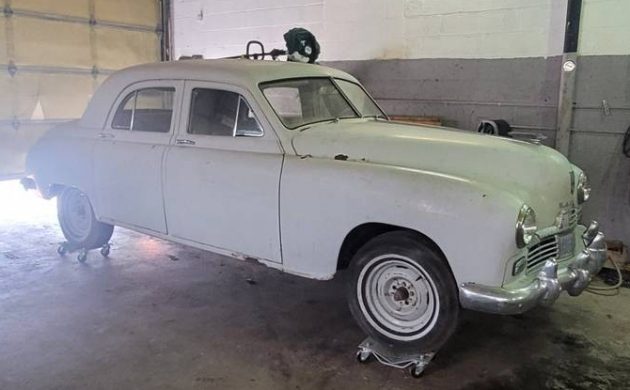
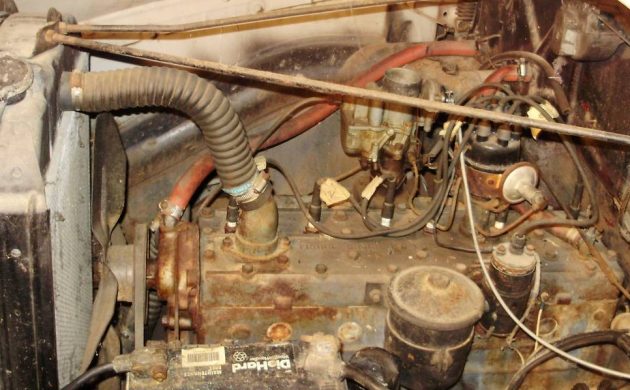
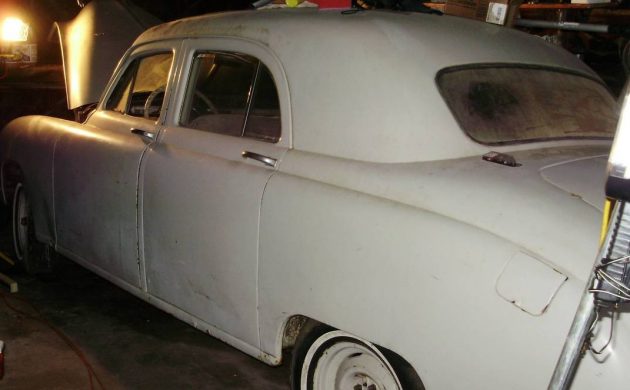
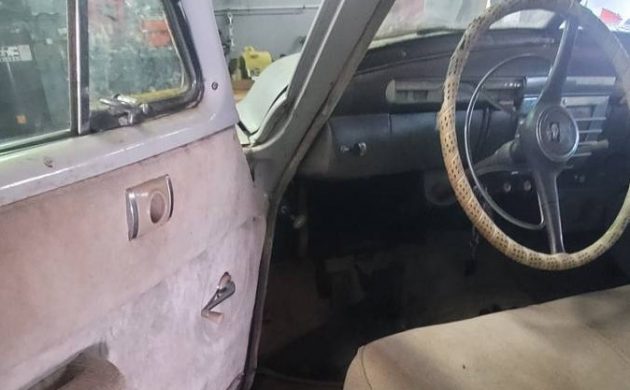
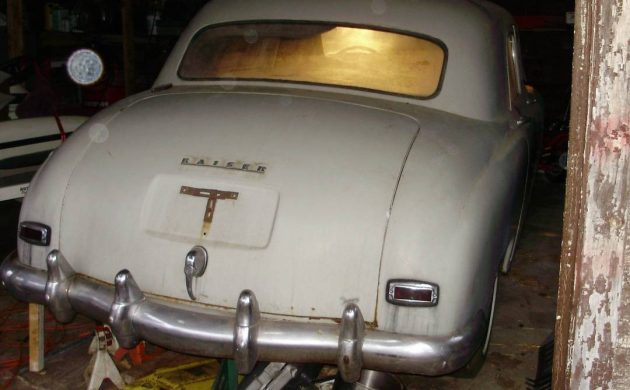


I don’t pretend to be a K-F expert, but that sure looks like it says Kaiser on the front with a large “K” on the steering wheel.
You know, you’re probably right. The hood badge, under the K, looked like “Frazer” to me, but upon further review, it reads Kaiser. That being the case, I have updated the post and take note that the listing should read Kaiser-Frazer.
Thx,
JO
Confusion between Frazer and Kaiser is understandable, they shared the same body until Frazer was discontinued after the 1951 model year, at which point Kaiser got a completely restyled body.
Both Kaiser and Frazer were completely restyled for the 1951 model year.
Frazer sales dipped in 1948 due to this reason. The Frazer was more expensive than the Kaiser, but was perceived by the car-buying public to be a similar car – hence greater sales for Kaiser.
I still believe every car guy/gal should have “Ran When Parked” on their headstone. For me, it’s a toss up between “Ran When Parked” or a rowing term used to describe oar placement in the water- “Squared and Buried”
my personal favorite salesman’s claim is “ready for paint”
How about: “ Hasn’t run in 12 years”?
BTW, my perception at the time was that they went down for lack of a V8. The best they could do was to offer a supercharger in 1954. But by 1955 everybody had a V8. Even Plymouth, Studebaker, Packard… The Kaiser was certainly a handsome car – way ahead of its time – although I preferred the ’54 trim. In ’55 they went rather birserk trying to freshen an aging body shell that did not need freshening.
Even if the supercharged six could compete with the V8s, it lacked the mystique, prestige, the magic of a V8. And by 1955 Americans were V8-crazy.
And furthermore… ‘ Hate to bash such a modestly-priced offering, but in the frontal photos, I am concerned about the shut-lines between hood and fenders – particularly on the drivers side where the shut-line is uneven – progressing from normal at the back to what looks like no gap at all at the front. Looking at the grill, it seems to be closing high on the drivers side. This all could point to poor collision repair. Whatever it is, we could hope that it can easily be fixed. But it could speak of chassis damage – still fixable, but at much greater expense.
Between Kaiser and Frazer, can somebody tell me which was intended to be the premium one? I couldn’t tell 70 years ago, and I still don’t know. At the time I thought both were pretty generic looking – like toy cars intended only to be “cars” – with no brand resemblence.
There’s no difference between the ’54 and ’55 Kaisers except for the VIN plates and a very modest change to the hood ornament which is almost unnoticeable.
“Down Goes Frazer!”, Down Goes Frazer!”. Feel free to carbon-date your self.
Lou,
Ya GOT me! Obviously I don’t know my K/Fs very well. And thanks for the nudge to go do some research. I was thinking of the chrome on the tail lights. So I went back and did a little research. Actually, the Manhattan that I liked the best was the ’52. The ‘51s looked a little skimpy in the trim department. In ’52 they went to the larger tail lights, and fundamentally the same grill design, but much more massive. In ’53 they started to get a bit silly with the tail light chrome, and in ’54 they went birserk with it. I was a year off in identifying that. Of course, I discovered you were right!
We’ve covered what great cars these were, even though pretty basic, but after the war, Americans were hungry for ANY kind of wheels, the cheaper, the better, and K-F had a following,,for a while. These used the Continental motor, probably left over from the war, Henry Kaiser. was the ultimate miser, I read, and was able to sell these cheap, around $2,200 new, equal to most others, but included options like dome lights, sun visors, arm rests, fresh air heater, all extra on other cars. K-F had a FWD in the works, but almost doubled the cost, and they couldn’t justify putting it into production. Can you imagine, considering where cars went, what a blunder that was, but nobody had a crystal ball, and many great ideas that were shelved, became big hits later. Not a hide burner, 0-60 in 19.1, 1/4 mile, about 21 seconds, so VW Bug performance, and surprisingly, not all that good of mileage, about 15 mpg, the O/D added nothing except lower R’s, and with no power, actually did little, but lower rev’s made it more comfortable. Life should be so simple again that this is all that we need,,
My dad told me more than one time that the only new car he could find after the war was a Kaiser-Frazer. He HATED it and said it was a POS.
That being said, they were nice-looking cars and made other ’48s look antiquated.
Not Studebaker
I remember my father had one just like the one shown and I remember him telling me the car weighed 4,000 pounds. 2 tons! Kaiser was obviously into steel.
3100 lbs.
https://www.automobile-catalog.com/make/kaiser/k-series_1/k100/1947.html
The Frazer cars were upper level to the Kaisers. There was even Frazers that were 4 door hard tops and four door convertibles in1948 and 1949. These are very beautiful cars and most enjoyable to own.. I do not see much enjoyment in a standard model with zero options. This car might not even have a radio o r heater. Even back up lights were an option on this car.
Reminds me a bit of my barebones 1962 Chevy 11 300.
The dome light coming on when the door opened was an option.
Worse yet, a windshield washer was an option. I used to carry a water pistol and squirt the windshield with it. This was an absolute necessity for driving in Montreal winters.
I finally bought a washer kit from Canadian Tire , it consisted of a foot pump with hoses leading to and fro.
Never did get it installed, the water pistol sufficed.
‘…during that time of mid/late -40s irrational exuberance for all things automotive.’
“Irrational exuberance”? There had been no production of automobiles for five years due to WWII.
Hardly “irrational exuberance”.
Exactly my point. There were about 3.6 MM cars sold in the U.S. in 1941, the last full year before U.S. involvement in WWII. By 1947, that number was back up to 3.5 MM, 3.9 MM in 1948, and 5.2 MM in 1949. Everyone was desperate to buy a new car and Detroit was delivering – doesn’t it seem logical that people were buying whatever they could get their hands on because of that pent-up demand? You could have sold buyers a powered dog cart; good, bad, or indifferent, they all sold, rational or not!
JO
I have a picture of my two brothers and me sitting on the fender of this car in front of our old farm house in Minnesota. I was two years old so it was a used car. We didn’t keep it long enough for me to have feelings for them as my Dad switched to Nashes and that’s what I grew up with. I still drive my 1951 Nash Ambassador to this day.
Nice write up Jim. I am a retired Hemmings Motor News editor and I know first the facts better be 100 percent before you print. I used to have Packard folk call me to me to complain about every time bit. There is a town in central PA that still has a Kaiser Frazer dealership standing complete with a neon sign. I cannot recall what town it is. I miss simple cars. Today’s cars do nothing for me. I have a 50 year old Corvette that is modern to me.
I love the old independent marques and have had a few, most notably a 1946 Hudson Commodore 8. This K-F, while priced well, is about as unremarkable of an old car as there is. Bland styling, 0 performance, and seemingly 0 options. Outside of the novelty of it being a K-F, I don’t think there’s much appeal here. Now a Kaiser Manhattan on the other hand will have me opening my wallet!
The best thing to do if you really want an off-brand/orphan car like this (or probably any special interest car) is to join whatever club exists for them, look at their club classifieds and be the next custodian of a car that has been lovingly cared for by someone who’s now 85 and just wants his/her car to go to someone who will love it as they did.
Thomas – Excellent advice! On several levels: you’ll learn so much about your car, where to find the right parts, how to solve the problems unique to your car, and you’ll make the greatest friends of your life! In fact, you’ll soon end up helping others with skills an knowledge you can’t even imagine now.
I’m bothered by just one part of your note: I’m 82; are you saying Imust sell my cars in three more years? What if I still maintain them and drive them? Any chance I can hang on to them until I’m 90? 92? How about 95?
I am saying no such thing. May you drive until you’re 105, sir!